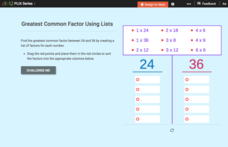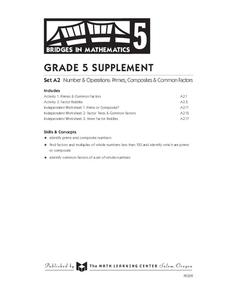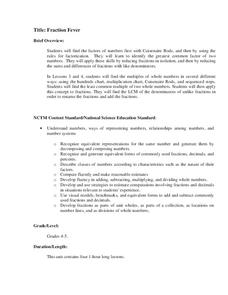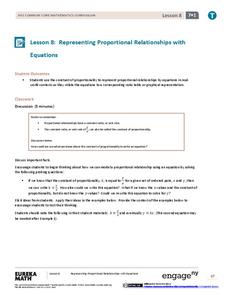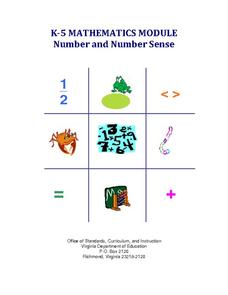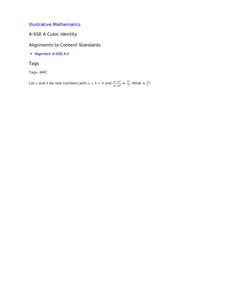Scholastic
Study Jams! Least Common Multiple
RJ instructs your sixth graders in two different methods of determining least common multiples. The first is by listing several multiples of each number, and the second is by drawing factor trees. This is an ideal flipped classroom...
Granite School District
6th Grade CCSS Math Vocabulary Word List
Simplify the Common Core Math Standards for sixth graders with this comprehensive list of key vocabulary. Complemented by a series of word cards that support the meaning of each term with images and examples, this resource provides...
EngageNY
Least Common Multiple and Greatest Common Factor
Find the common denominator between prime factors, factor trees, and the distributive property. Scholars learn to find the least common multiple and greatest common factor of pairs of numbers. They rotate through stations to connect...
Mathed Up!
HCF, LCM, and Product of Primes
Give the class a prime example of using prime numbers. After reviewing prime factorization of numbers with the video, pupils use their knowledge to determine greatest common factors and least common multiples in the worksheet. The...
Scholastic
Study Jams! Multiples
Cupcakes and pancakes help teach young mathematicians about multiples in this mouth-watering presentation. Watch and learn how knowing her multiples helps Zoe bake enough desserts for her birthday party. Following the presentation, go...
CK-12 Foundation
Greatest Common Factor Using Lists
By creating a list of factors for two numbers, it is easier to see the greatest common factor. Each question in an interactive resource asks pupils to identify the greatest common factor for the numbers 24 and 36 in several...
Math Learning Center
Grade 5 Supplement Set A2 – Number and Operations: Primes, Composites and Common Factors
Incorporate riddles into your math lesson by having students make tree factors and determine if the number is a prime or composite. They will also use other clues to find the answer to the riddle while sharpening their...
Scholastic
Study Jams! Simplest Form
Make math simple with this step-by-step presentation on fractions in their simplest form. Multiple approaches are introduced including, most efficiently, the division of numerators and denominators by their greatest common factor. Work...
CK-12 Foundation
Monomial Factors of Polynomials: Mystery Boxes
Shortcut the work in finding total volumes. Pupils determine a polynomial expression that would represent the combined volume of three boxes. Each box has the same height, and the scholars rewrite the expression by factoring out the...
Scholastic
Study Jams! Prime Factorization
Deepen the number sense of young mathematicians by exploring the process of prime factorization. Follow along with this step-by-step presentation that explains how factor trees are used to break a composite number down into its prime...
National Security Agency
Fraction Fever
This unit on fractions allows for upper-aged elementary learners to explore ways to find the greatest common factor and least common multiple of two numbers. Ultimately, young mathematicians will be able to identify equivalent fractions,...
EngageNY
Representing Proportional Relationships with Equations
Use the constant of proportionality to relate the independent variable to the dependent variable. The eighth installment of a 22-part series instructs pupils to use the equation to find the constant of proportionality and then write the...
EngageNY
Dilations on the Coordinate Plane
Dilations from the origin have a multiplicative effect on the coordinates of a point. Pupils use the method of finding the image of a point on a ray after a dilation to find a short cut. Classmates determine the short cut of being...
EngageNY
Matrix Notation Encompasses New Transformations!
Class members make a real connection to matrices in the 25th part of a series of 32 by looking at the identity matrix and making the connection to the multiplicative identity in the real numbers. Pupils explore different...
West Contra Costa Unified School District
Factoring Quadratic Expressions
Factor in different strategies in a lesson for factoring quadratics. Young mathematicians first create tables and area models to factor quadratic trinomials into two binomials by guess and check. Learners then investigate how they can...
Curated OER
K-5 Mathematics Module: Number and Number Sense
Reinforce number sense with a collection of math lessons for kindergarteners through fifth graders. Young mathematicians take part in hands-on activities, learning games, and complete skills-based worksheets to enhance proficiency...
West Contra Costa Unified School District
Simplifying Radicals – Day 1
It doesn't get simpler than this. Scholars first learn to simplify radicals by determining the prime factors of the radicand. The lesson progresses to simplifying radicals involving algebraic expressions in the radicand.
CK-12 Foundation
Conversions between Degrees and Radians: Charting Hours in the Day
Forget hours, divide the day into radians instead. Class members convert the angles in a pie chart of daily activities into radian measures. They add angle measures for multiple activities then determine a relationship between the radian...
Corbett Maths
Adding Algebraic Fractions
The process requires the combination of several concepts. A video shows how individuals need several concepts to add rational expressions. Pupils must remember they need to find common denominators, combine like terms, and use the...
EngageNY
Factoring Expressions
Factor in an informative resource when teaching about factoring. The 11th activity in a 36-part module shows pupils how to factor algebraic expressions by applying the distributive property. Some of the problems involve expressions with...
Serendip
Understanding and Predicting Changes in Population Size – Exponential and Logistic Population Growth Models vs. Complex Reality
Salmonella poisoning impacts over 200,000 people in the United States each year. Scholars learn about the growth of these bacteria using multiple approaches. Then they apply the same growth calculations to endangered species and think...
EngageNY
Applying the Properties of Operations to Multiply and Divide Rational Numbers
Use properties to evaluate several multiplications and divisions. The 16th lesson in a series of 25 demonstrates to scholars how they can utilize properties of operations to evaluate complex numerical expressions involving multiplication...
Illustrative Mathematics
Radius of a Cylinder
Here is a multiple choice question that would make a good assessment question. Algebra students are to look at the structure of the formula for a given radius of a cylinder and find the resulting radius when the height of the...
Illustrative Mathematics
An Integer Identity
Challenge algebra learners to use the difference of cubes to solve this problem. Once your charges have taken out the factor (a - b), combined the like terms and set them equal to zero, the problem becomes a factorable quadratic...




